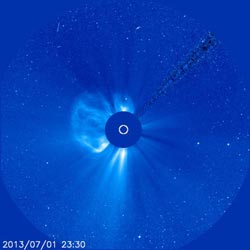

Experimental NASA research models based on NASA’s Solar Terrestrial Relations Observatory show that the CME was not Earth-directed and it left the sun at around 570 miles per second.
The CME may, however, pass by NASA’s Messenger, Spitzer and STEREO-B satellites, and their mission operators have been notified.
There is only very slight particle radiation associated with this event, which is what would normally concern operators of interplanetary spacecraft, because the particles can trip computer electronics aboard interplanetary spacecraft.
If warranted, operators can put spacecraft into safe mode to protect the instruments from the solar material.
NOAA's Space Weather Prediction Center (http://swpc.noaa.gov) is the U.S. government's official source for space weather forecasts, alerts, watches and warnings.
Updates will be provided as needed.
Karen C. Fox
NASA's Goddard Space Flight Center, Greenbelt, Md.












